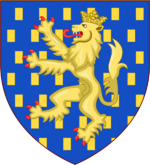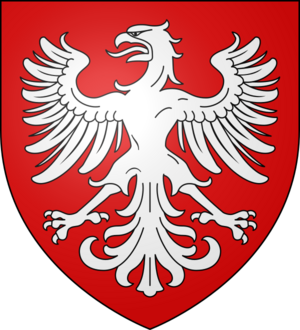Anscarids facts for kids
Quick facts for kids House of IvreaCasa di Ivrea
Maison d'Ivrée Anscarids
|
|
|---|---|
| Royal family | |
 |
|
| Country | Holy Roman Empire Kingdom of Italy Frankish Empire Papal States County of Burgundy Galicia, Castile, León and Kingdom of Aragon |
| Founded | 9th century |
| Founder | Anscar I |
| Final ruler | Italy: Arduin Burgundy: Joan II Castile, Galicia and León: Peter (Spain) Union of Castile and Aragon: Joanna the Mad (illegitimate line) Orange: Philibert |
| Titles |
|
| Dissolution | 1369 |
| Cadet branches |
|
The Anscarids or the House of Ivrea was a powerful family from the Middle Ages. They started in the area of France and became very important in Northern Italy during the 900s. For a short time, they even ruled the Kingdom of Italy.
The main part of the family ruled the County of Burgundy from the 1000s to the 1300s. One of their members was the first to call himself a count palatine, which was a special title. A related branch, called the Castilian branch of Ivrea, ruled the Kingdom of Galicia starting in 1111. They also ruled the Kingdoms of Castile and León from 1126 until 1369. The House of Trastámara, another branch of this family, later ruled in Castile, Aragon, Naples, and Navarre.
Contents
The Ivrea Family's Beginnings
The person who started the family's rise to power was a count named Anscar. He was from Burgundy. With help from his powerful brother, Fulk the Venerable, who was the archbishop of Rheims, Anscar supported Guy III of Spoleto. They tried to make Guy King of France in 887, but it didn't work out.
After their plan failed, Anscar went with Guy to Italy. Guy wanted to become King of Italy instead. To thank Anscar for his loyalty, Guy created the March of Ivrea and gave it to him. Anscar's family kept control of this area until 1030.
One of the most famous members of the family was Anscar's grandson, Berengar. He was the first of three Anscarids to become King of Italy.
Berengar II: King of Italy
Berengar took the throne in 950 after Lothair II died. Lothair's widow, Adelaide, was against him. Berengar even put her in prison when she refused to marry his son, Adalbert II.
Emperor Otto I came to Italy and made Berengar promise to be loyal to him in 952. For the next eleven years, Berengar and his son ruled Italy together. But in 963, Otto officially removed them from power.
Later, from 1002 to 1014, Arduin of Italy held the Italian throne. He was against the German emperor, Henry II.
Counts of Burgundy
Adalbert, Berengar's son, had to escape to Burgundy. He died there. His wife later married Otto-Henry, Duke of Burgundy. Adalbert's son, Otto William, was adopted by the duke.
In 982, the County of Burgundy was created. This area would later be known as the Free County. Otto-Henry helped Otto-William become its first count. When the duke died, Otto-William inherited the duchy of Burgundy. However, after a meeting in 1015, Robert II of France and his son, Henry I of France, took away most of the duchy. Otto-William was left with only a small part around Dijon.
The Franc-Comte Title
The most important of the Free Counts was Renaud III. In 1127, he started using the title franc-comte. This title showed that he wanted to be independent from German or Imperial rule. But he was forced to give in to Conrad III.
Renaud's daughter and heir, Beatrice, married Frederick Barbarossa. This marriage brought the Anscarid family's lands together with those of the Hohenstaufen family. Burgundy was then inherited by her son, Otto I.
The county was lost to the House of Ivrea for a while. But it came back when Hugh of Chalon married Adelaide. Adelaide was the Countess of Burgundy and the daughter of Beatrice II of Hohenstaufen. However, in 1303, Otto IV, Count of Burgundy, the last male from the main line, died. The county then passed to the Dampierre family and later to the Capetian-Valois dukes of Burgundy.
The Chalon-Arlay Branch
John I of Chalon-Arlay, who was a younger brother of Hugh of Chalon, started the Chalon-Arlay family line. One of his descendants, John III of Chalon-Arlay, married Mary de Beaux, a princess of Orange. This is how the family gained control of the Principality of Orange. The last male in this line was Philibert of Chalon, who died in 1530. His possessions went to the son of his sister, Claudia of Chalon, who was René of Nassau.
The Castilian Branch of Ivrea
Raymond, the fourth son of Count William I of Burgundy, traveled to Castile-León in the late 1000s. There, he married Urraca, who would later become queen. Their son, Alfonso VII, became king after Urraca.
The kings of Castile and León after Alfonso VII were all descendants of Raymond and Urraca. This continued until the 1500s. However, the crown later passed to a different branch of the family, the House of Trastámara, in the late 1300s.
Family tree of House of Ivrea
| Anscar I margrave of Ivrea HOUSE OF IVREA |
Fulk Archbishop of Reims |
||||||||||||||||||||||||||||||||||||||||||||
| Adalbert I margrave of Ivrea |
|||||||||||||||||||||||||||||||||||||||||||||
| Berengar II margrave of Ivrea, king of Lombards in Italy |
Anscar II duke of Spoleto |
||||||||||||||||||||||||||||||||||||||||||||
| Gerberga of Chalon |
Adalbert II co-king of Lombards in Italy |
Guy margrave of Ivrea |
Conrad margrave of Ivrea |
Dado count of Pombia |
|||||||||||||||||||||||||||||||||||||||||
| Otto William count of Burgundy |
Arduin margrave of Ivrea, king of Lombards in Italy |
||||||||||||||||||||||||||||||||||||||||||||
| Reginald I count of Burgundy |
|||||||||||||||||||||||||||||||||||||||||||||
| William I count of Burgundy |
Guy count of Brionne |
||||||||||||||||||||||||||||||||||||||||||||
| Reginald II count of Burgundy |
Stephen I count of Burgundy |
(Guy) Pope Callixtus II |
Raymond count of Galicia CASTILIAN HOUSE OF IVREA |
Urraca queen of Castile & León HOUSE OF JIMENEZ |
|||||||||||||||||||||||||||||||||||||||||
| William II count of Burgundy |
Reginald III count of Burgundy |
William III count of Mâcon |
|||||||||||||||||||||||||||||||||||||||||||
| William III count of Burgundy |
Beatrice I countess of Burgundy |
Stephen II count of Auxonne |
|||||||||||||||||||||||||||||||||||||||||||
| Otto I of Hohenstaufen count of Burgundy |
Stephen III count of Auxonne |
||||||||||||||||||||||||||||||||||||||||||||
| Beatrice II of Hohenstaufen countess of Burgundy |
John count of Chalon |
||||||||||||||||||||||||||||||||||||||||||||
| Adelaide of Andechs countess of Burgundy |
Hugh | John I count of Auxerre |
John I lord of Arlay HOUSE OF ARLAY |
Hugh archbishop of Besançon |
|||||||||||||||||||||||||||||||||||||||||
| Otto IV count of Burgundy |
Reginald | ||||||||||||||||||||||||||||||||||||||||||||
| Joan II countess of Burgundy |
Othenin count of Montbéliard |
||||||||||||||||||||||||||||||||||||||||||||
See Also
 In Spanish: Casa de Ivrea para niños
In Spanish: Casa de Ivrea para niños
- House of Chalon-Arlay, another branch of the Anscarids, which later ruled the Principality of Orange.
- Portuguese House of Burgundy, a branch of the House of Capet, which ruled Portugal at the same time as the Castilian House of Ivrea.
Sources
- Wickham, Chris. Early Medieval Italy: Central Power and Local Society 400–1000. MacMillan Press: 1981.
|
— Royal house —
House of Ivrea
|
||
| Preceded by (founder) |
 counts of Burgundy 982–1190 |
Succeeded by House of Hohenstaufen |
|
— Royal house —
House of Ivrea
|
||
| Preceded by House of Andechs |
 counts of Burgundy 1279–1330 |
Succeeded by House of Capet |


